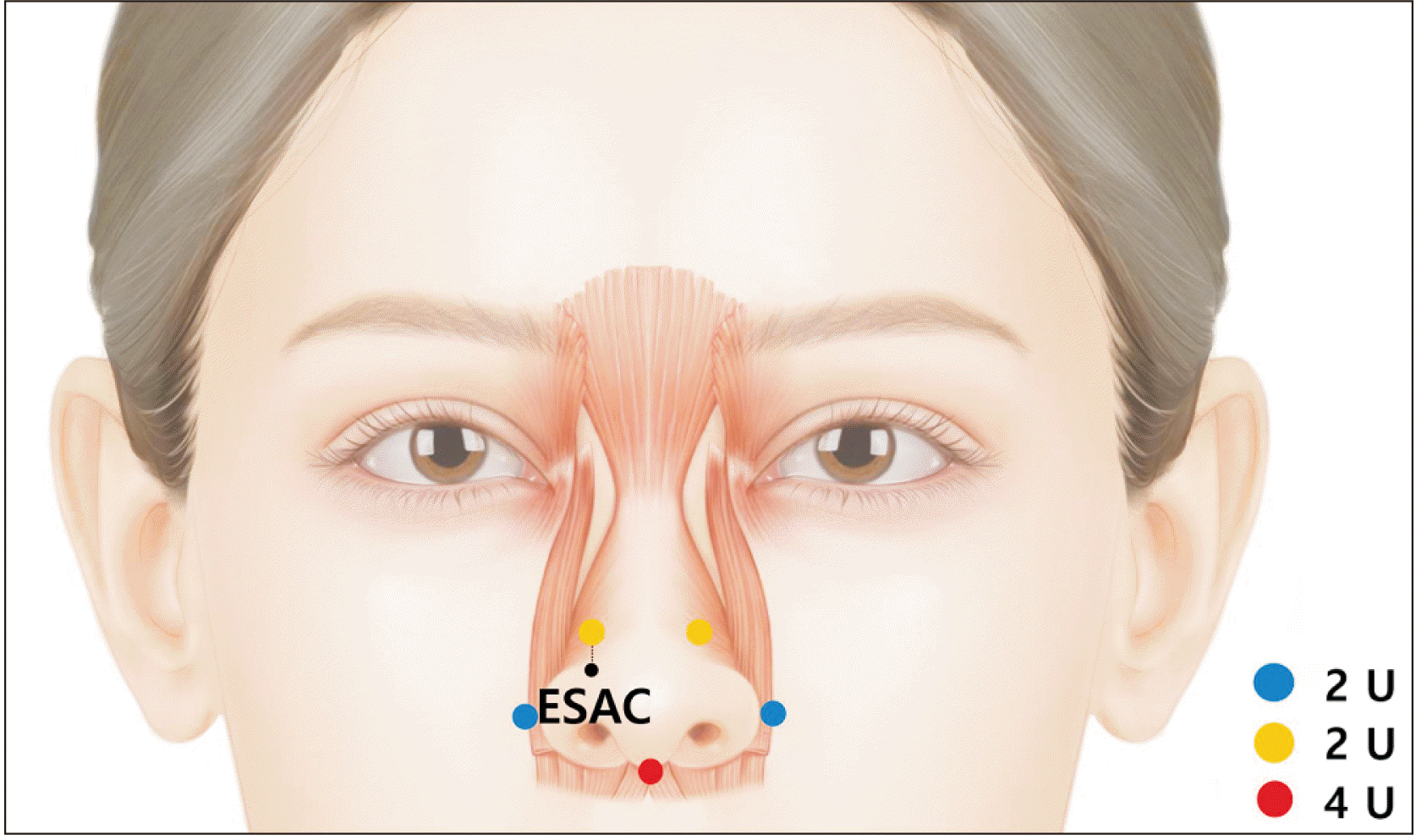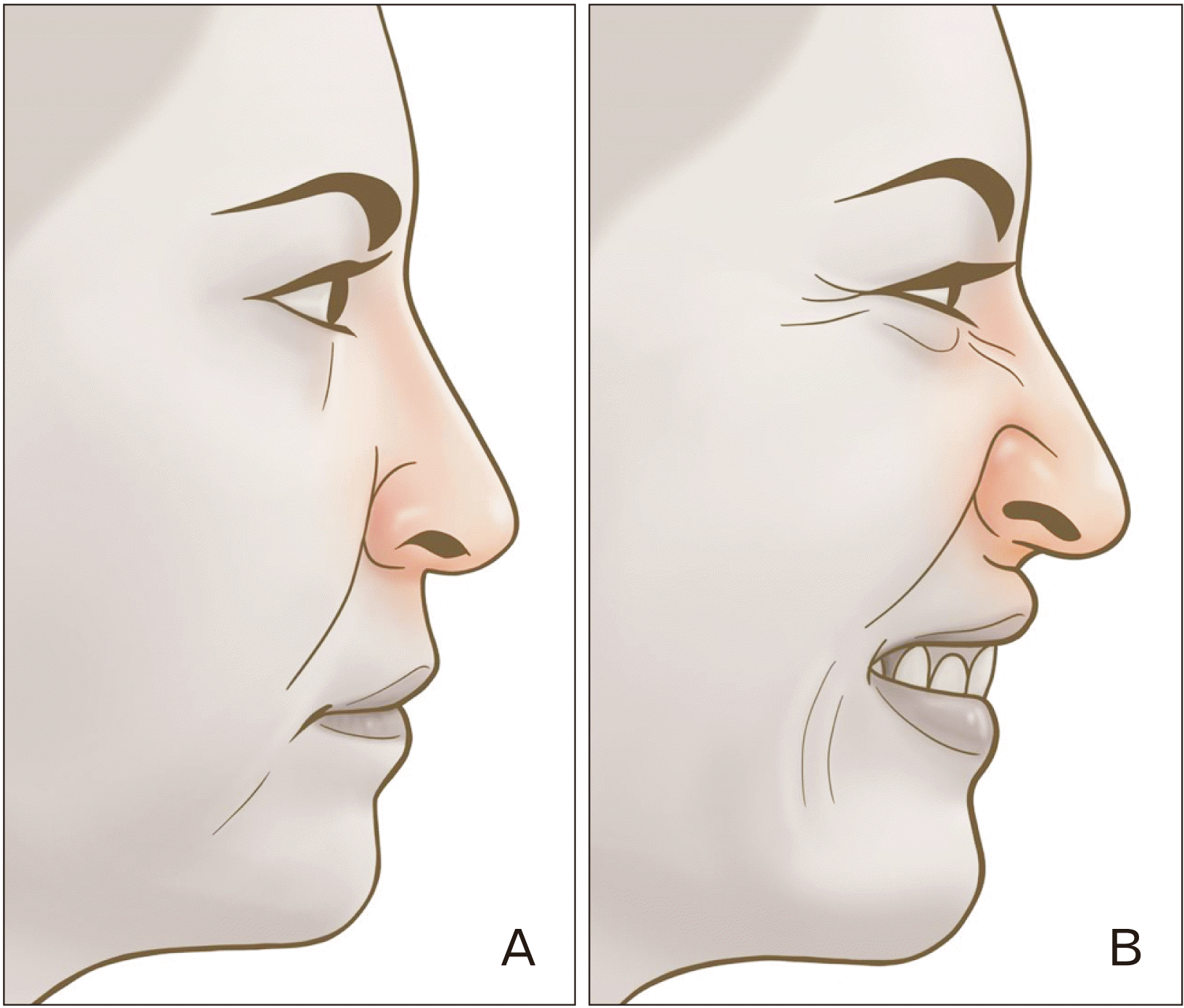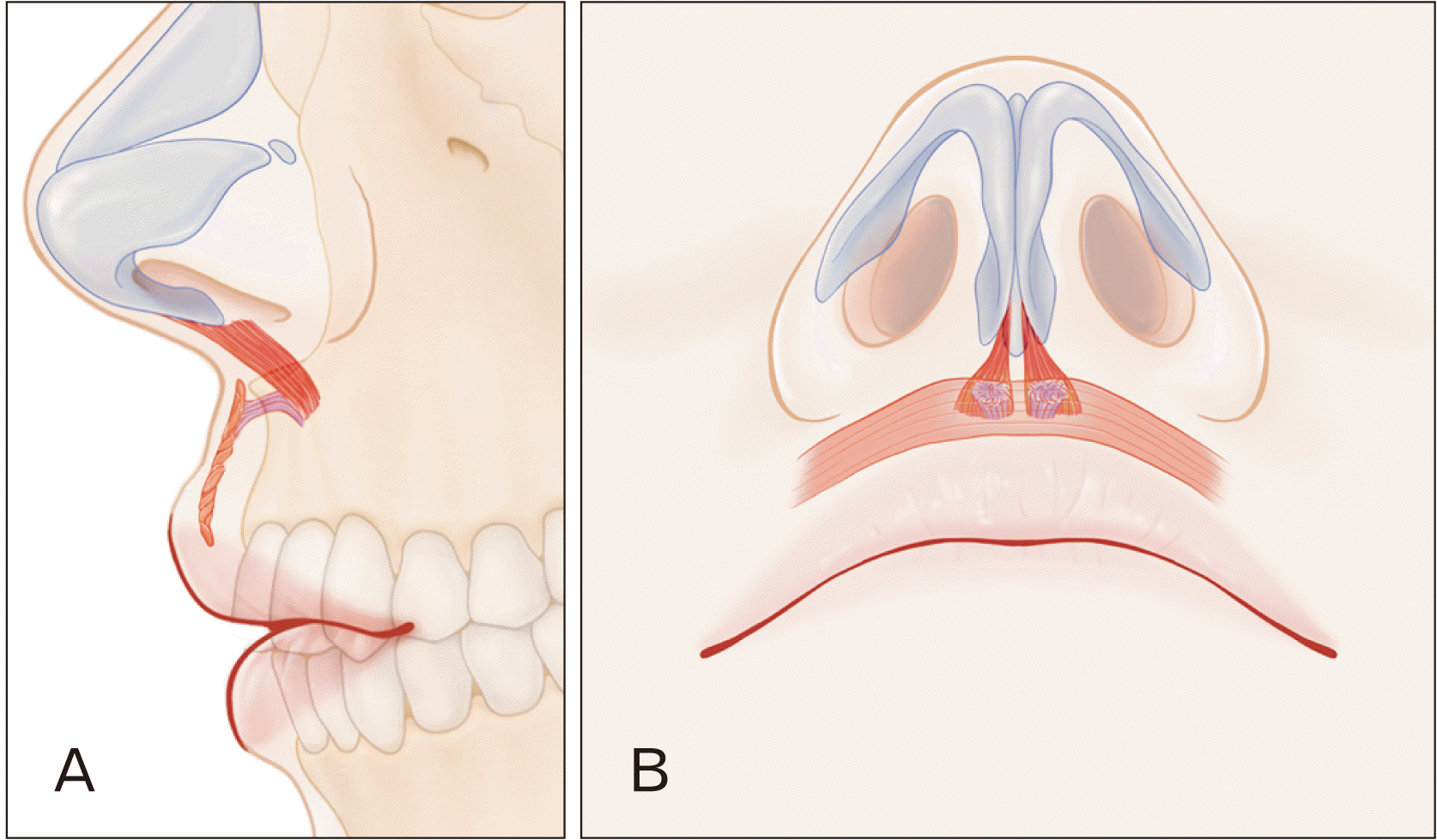1. Dessy LA, Mazzocchi M, Rubino C, Mazzarello V, Spissu N, Scuderi N. 2007; An objective assessment of botulinum toxin A effect on superficial skin texture. Ann Plast Surg. 58:469–73. DOI:
10.1097/01.sap.0000244968.16977.1f. PMID:
17452827.

3. Yi KH, Cong L, Bae JH, Park ES, Rha DW, Kim HJ. 2017; Neuromuscular structure of the tibialis anterior muscle for functional electrical stimulation. Surg Radiol Anat. 39:77–83. DOI:
10.1007/s00276-016-1698-6. PMID:
27206542.

4. Rha DW, Yi KH, Park ES, Park C, Kim HJ. 2016; Intramuscular nerve distribution of the hamstring muscles: Application to treating spasticity. Clin Anat. 29:746–51. DOI:
10.1002/ca.22735. PMID:
27213466.

5. Lee JJ, Yi KH, Kim HS, An MH, Seo KK, Chang-Hun H, Kim HJ. 2022; A novel needle-free microjet drug injector using Er:YAG LASER: a completely new concept of transdermal drug delivery system. Clin Anat. 35:682–5. Erratum in: Clin Anat 2022; 35:1152. DOI:
10.1002/ca.23892. PMID:
35445437.
8. Lee HJ, Lee JH, Yi KH, Kim HJ. 2023; Sonoanatomy and an ultrasound scanning protocol of the intramuscular innervation pattern of the infraspinatus muscle. Reg Anesth Pain Med. 48:175–9. DOI:
10.1136/rapm-2022-103682. PMID:
36427902.

9. Kim HM, Ree YS, Park MS, Kim JS, Ahn JH, Yi KH. 2022; Clinical guideline: deoxycholic acid injection for submental fat reduction. The Aesthetics. 3:7–11. DOI:
10.46738/Aesthetics.2022.3.2.7.

12. Yi KH, Lee JJ, Hur HW, Bae H, Kim HJ. 2022; Hyaluronic acid filler injection for deep nasolabial folds: a novel intraoral approach. Clin Anat. 35:820–3. DOI:
10.1002/ca.23919. PMID:
35665540.

14. Yi KH, Lee HJ, Seo KK, Kim HJ. 2022; Botulinum neurotoxin injection guidelines regarding flap surgeries in breast reconstruction. J Plast Reconstr Aesthet Surg. 75:503–5. DOI:
10.1016/j.bjps.2021.09.081. PMID:
34776389.

16. Yi KH, Lee HJ, Choi YJ, Lee K, Lee JH, Kim HJ. 2021; Anatomical guide for botulinum neurotoxin injection: application to cosmetic shoulder contouring, pain syndromes, and cervical dystonia. Clin Anat. 34:822–8. DOI:
10.1002/ca.23690. PMID:
32996645.

18. Yi KH, Lee JH, Kim HM, Kim HJ. 2022; The botulinum neurotoxin for pain control after breast reconstruction: neural distribution of the pectoralis major muscle. Reg Anesth Pain Med. 47:322–6. DOI:
10.1136/rapm-2021-102653. PMID:
35039438.

20. Yi KH, Lee HJ, Hur HW, Seo KK, Kim HJ. 2022; Guidelines for botulinum neurotoxin injection for facial contouring. Plast Reconstr Surg. 150:562e–71e. DOI:
10.1097/PRS.0000000000009444. PMID:
35759641.

22. Fagien S, Brandt FS. 2001; Primary and adjunctive use of botulinum toxin type A (Botox) in facial aesthetic surgery: beyond the glabella. Clin Plast Surg. 28:127–48. DOI:
10.1016/S0094-1298(20)32345-2. PMID:
11248863.
23. Lee W, Ahn TH, Cheon GW, Lee MJ, Yang EJ. 2021; Comparative analysis of botulinum toxin injection after corrective rhinoplasty for deviated nose and alar asymmetry. J Cosmet Dermatol. 20:451–6. DOI:
10.1111/jocd.13523. PMID:
32557986.

27. Hsu TS, Dover JS, Arndt KA. 2004; Effect of volume and concentration on the diffusion of botulinum exotoxin A. Arch Dermatol. 140:1351–4. DOI:
10.1001/archderm.140.11.1351. PMID:
15545544.

29. Lepage D, Parratte B, Tatu L, Vuiller F, Monnier G. 2005; Extra- and intramuscular nerve supply of the muscles of the anterior antebrachial compartment: applications for selective neurotomy and for botulinum toxin injection. Surg Radiol Anat. 27:420–30. DOI:
10.1007/s00276-005-0012-9. PMID:
16308665.

30. Pingel J, Nielsen MS, Lauridsen T, Rix K, Bech M, Alkjaer T, Andersen IT, Nielsen JB, Feidenhansl R. 2017; Injection of high dose botulinum-toxin A leads to impaired skeletal muscle function and damage of the fibrilar and non-fibrilar structures. Sci Rep. 7:14746. DOI:
10.1038/s41598-017-14997-3. PMID:
29116170. PMCID:
PMC5677119.

31. Yi KH, Lee KL, Lee JH, Hu HW, Lee K, Seo KK, Kim HJ. 2021; Guidelines for botulinum neurotoxin injections in piriformis syndrome. Clin Anat. 34:1028–34. DOI:
10.1002/ca.23711. PMID:
33347678.

32. Yi KH, Lee JH, Lee DK, Hu HW, Seo KK, Kim HJ. 2021; Anatomical locations of the motor endplates of sartorius muscle for botulinum toxin injections in treatment of muscle spasticity. Surg Radiol Anat. 43:2025–30. DOI:
10.1007/s00276-021-02813-7. PMID:
34378107. PMCID:
PMC8354843.

33. Yi KH, Lee HJ, Lee JH, Lee KL, Kim HJ. 2021; Effective botulinum neurotoxin injection in treating iliopsoas spasticity. Clin Anat. 34:431–6. DOI:
10.1002/ca.23670. PMID:
32805076.

35. Yi KH, Lee JH, Hur HW, Lee HJ, Choi YJ, Kim HJ. Distribution of the intramuscular innervation of the triceps brachii: clinical importance in the treatment of spasticity with botulinum neurotoxin. Clin Anat 2023 Jan 6 [Epub].
https://doi.org/10.1002/ca.24004. DOI:
10.1002/ca.24004. PMID:
36606364.

37. Yi KH, Rha DW, Lee SC, Cong L, Lee HJ, Lee YW, Kim HJ, Hu KS. 2016; Intramuscular nerve distribution pattern of ankle invertor muscles in human cadaver using Sihler stain. Muscle Nerve. 53:742–7. DOI:
10.1002/mus.24939. PMID:
26467315.

39. Rohrich RJ, Huynh B, Muzaffar AR, Adams WP Jr, Robinson JB Jr. 2000; Importance of the depressor septi nasi muscle in rhinoplasty: anatomic study and clinical application. Plast Reconstr Surg. 105:376–83. discussion 384–8. DOI:
10.1097/00006534-200001000-00061. PMID:
10627007.

40. Cigna E, Sorvillo V, Stefanizzi G, Fino P, Tarallo M. 2013; The use of botulinum toxin in the treatment of plunging nose: cosmetic results and a functional serendipity. Clin Ter. 164:e107–13.
41. Kim JW, Choi YJ, Lee HJ, Yi KH, Kim HJ, Hu KS. 2015; Anatomic study of the dorsalis pedis artery, first metatarsal artery, and second metatarsal bone for mandibular reconstruction. J Oral Maxillofac Surg. 73:1627–36. DOI:
10.1016/j.joms.2015.02.007. PMID:
25930957.

42. Yi KH, Lee KL, Lee JH, Hu HW, Kim HJ. 2022; Guidance to trigger point injection for treating myofascial pain syndrome: intramuscular neural distribution of the quadratus lumborum. Clin Anat. 35:1100–6. DOI:
10.1002/ca.23918. PMID:
35655442.

43. Yi KH, Choi YJ, Cong L, Lee KL, Hu KS, Kim HJ. 2020; Effective botulinum toxin injection guide for treatment of cervical dystonia. Clin Anat. 33:192–8. DOI:
10.1002/ca.23430. PMID:
31301235.

44. Yi KH, Kim HJ. 2021; Is variation in posterior tibial veins a risk factor for deep-vein thrombosis? Clin Anat. 34:829–34. DOI:
10.1002/ca.23691. PMID:
32996214.

45. Yi KH, Lee JJ, Hur HW, Kim HJ. 2021; Anatomical consideration of deep calf veins: application to catheter-directed thrombolysis. Surg Radiol Anat. 43:2071–6. DOI:
10.1007/s00276-021-02821-7. PMID:
34432130. PMCID:
PMC8385696.

47. Daniel RK, Glasz T, Molnar G, Palhazi P, Saban Y, Journel B. 2013; The lower nasal base: an anatomical study. Aesthet Surg J. 33:222–32. Erratum in: Aesthet Surg J 2013;33:619. DOI:
10.1177/1090820X12472695. PMID:
23335645.

48. Sundaram H, Signorini M, Liew S, Trindade de Almeida AR, Wu Y, Vieira Braz A, Fagien S, Goodman GJ, Monheit G, Raspaldo H. 2016; Global aesthetics consensus: botulinum toxin type A--evidence-based review, emerging concepts, and consensus recommendations for aesthetic use, including updates on complications. Plast Reconstr Surg. 137:518e–29e. DOI:
10.1097/01.prs.0000475758.63709.23. PMID:
26910696. PMCID:
PMC5242214.
49. De Souza Pinto EB, Da Rocha RP, Filho WQ, Neto ES, Zacharias KG, Amâncio A, Braz de Camargo A. 1998; Anatomy of the median part of the septum depressor muscle in aesthetic surgery. Aesthetic Plast Surg. 22:111–5. DOI:
10.1007/s002669900175. PMID:
9502842.

50. Benlier E, Top H, Aygit AC. 2005; A new approach to smiling deformity: cutting of the superior part of the orbicularis oris. Aesthetic Plast Surg. 29:373–7. discussion 378DOI:
10.1007/s00266-004-0137-y. PMID:
16151663.

51. Preceruti P. 2001; Importance of the depressor septi nasal muscle in rhinoplasty: anatomic study and clinical application. Plast Reconstr Surg. 107:1081–2. DOI:
10.1097/00006534-200104010-00036. PMID:
11277123.





 PDF
PDF Citation
Citation Print
Print





 XML Download
XML Download